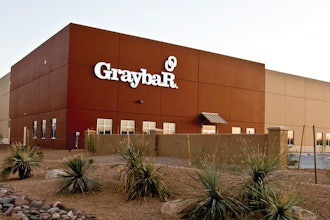
Any sufficiently advanced technology is indistinguishable from magic.
- Arthur C. Clarke
Software is a tool, like a screwdriver or a clothes dryer. It helps you get things done. But the invisible nature of how it works, and the remarkable number of problems it can solve in a short time, can make it seem almost miraculous at times.
This is a look at technology many have heard of but never used: visual search, the ability to locate files using shape, and its effect on manufacturing and distribution.
First, a quick spin back in time.
Personal computers began their unstoppable march across the workplace in the 1980s. Suddenly, data began to reside in a digital space instead of filing cabinets and blueprint drawers. By the early ‘90s, people who had never used a computer suddenly had thousands of digital files in digital folders.
This solved many challenges, but created a new one: how to find an electronic file when you weren’t sure what it was called or where it was stored.
So, in the ‘90s, developers began work on desktop search tools, which became increasingly fast and accurate. These only searched local files and networks. But as the use of text search grew, its limitations became apparent.
The fundamental problem was this: the desired information is often defined by its shape, not by text.
Manufacturers and distributors often found searches to be tedious -- and ultimately fruitless -- because of the constraints of language. They could not type a description that produced a match.
Another compounding factor was terminology. Three engineers working on nearly identical parts might discover that one named the part a bracket, the other called it a flange, and the third called it a base. And those are all people working in the same building and speaking the same language. Add in industry variations, plus 6900 languages across the globe, and the text search tools proved frustrating.
In 2012, management consultants McKinsey & Company reported* that “employees spend 1.8 hours every day -- 9.3 hours per week, on average -- searching and gathering information. Put another way, businesses hire 5 employees but only 4 show up to work; the fifth is off searching for answers, but not contributing any value.”
Thus, this need to locate files by shape, plus the inability to do so, gave rise to the development of visual search technology for shapes stored in digital data.
Although North American manufacturing has been very slow to adopt visual search technology, manufacturers in Asia and Europe are actively engaged in using visual search, with measurable increases in productivity.
Types of visual search
There are three types of visual search engines for shapes:
- Image to Image
- 3D to 3D
- Cross-Platform
These are designated in shorthand by replacing the word to with >, such as Image>Image.
IMAGE>IMAGE
Image>Image is for product visual search, almost always consumer goods. It works by using a photo of a desired product, such as shoes. It then uses this digital photo to find similar digital photos, either on the internet or on the website of an online retailer.
As ecommerce continues to supplant brick-and-mortar stores, online retailers have discovered the benefits of allowing their customers to drag and drop a photo of a desired item or locate it with a phone app:
- it overcomes language barriers;
- it overcomes terminology barriers, since shoppers may not know the name of a product;
- it allows online retailers to recommend similar products, since the consumer may actually be looking for products more or less like this one, not necessarily an exact match;
- it greatly accelerates the shopping process by finding the product faster than a text search or catalog perusal would.
For Image>Image web searches, the search engine, such as Google Images, produces results from its database of images scraped from millions of web pages. This is not proprietary data, but rather visual information readily available on the internet.
For Image>Image searches in a private ecommerce database (known as a “local search”), consumers are encouraged to use visual search to locate a match, either with a mobile device or a desktop drag and drop feature. This search is limited to those items in the database of the manufacturer, distributor or retailer.
In such instances, the visual search engine acts as a recommendation tool. It is not important to the online retailer that the consumer find an exact match. The web site will bring up the closest catalog match, and will also bring up similar results.
Image>Image search requires digital photographs both as search input and as search targets. This technology works well. Consumer goods are commonly photographed from many angles for marketing, so there is an abundance of images available for search.
The technology then uses deep learning, a form of machine learning (or artificial intelligence), to become increasingly familiar with the data for more accurate results. That is, as users repeatedly search for a product using visual input, the image>image search engine makes note of the correct match, as indicated by the shoppers’ selections, and uses that data to improve future searches.
3D>3D
This category encompasses both 2- and 3-dimensional engineering drawings, with searches conducted in a company’s secure database, not on the web. A software system may specialize in one of these platforms, or both, or may cross between 2D and 3D. The designation 3D>3D is used here to include both.
Engineers use 3D>3D searches to find needed models and to avoid duplicated effort. This technology uses a complete or partial 3D rendering to locate existing drawings of part, and may first require text to narrow the category search.
Unlike image>image searches, which are useful for both finding and recommending consumer goods, the goal of 3D>3D searches is an exact match. The search returns may be ranked in order of probability of match, but in an engineering environment, recommendations within a product category serve no purpose.
There are many advantages to finding 3D models in this way:
- it overcomes language barriers for companies that have engineers and designers creating models in different languages;
- it overcomes terminology barriers, since engineers may use different nomenclature for the same part;
- it overcomes difficulties in naming protocols following a merger or buyout, when engineers are accessing an unfamiliar database;
- it allows engineers to start a drawing, then pull up matches using the partial drawing to “save as” and work from existing models, eliminating duplicated work.
3D>3D DUPLICATE PART SEARCH
A further benefit is the ability to take an engineering model and search for duplicates. Large manufacturers and distributors frequently have parts that are so similar that they could be considered duplicates. But since they were developed independently, they require separate tooling, material specifications, etc., and are tracked with separate part numbers.
This is a significant financial drain for all parties involved, yet without visual search, it is impossible to know these duplicate parts exist. This technology thus creates the possibility of consolidating the number of parts in production and distribution, streamlining inventory.
3D>3D search only works, however, if there is access to the 3D models. Distributors handling industrial goods who do not have access to the engineering models will be out of luck.
CROSS-PLATFORM
Cross-platform search technology allows users to perform all of the functions of image>image and 3D>3D searches above, as well as perform searches across file or platform types, such as image>2D, 2D>2D, pdf>3D, hand-sketch>3D, etc.
This is significant for industrial producers and distributors. The critical issue for aftermarket sales is that millions of industrial parts are in the field that have never been individually photographed. With no digital photo in the database image>image search does not work.
Equally, even if there are engineering models in the database, the end user in the field does not have the 3D model to drag and drop to perform a search, so 3D>3D search does not work.
Cross-platform search solves this aftermarket difficulty by using digital engineering drawings, pdfs, photos and other shapes, such as exploded views and electronic catalogs, as search targets.
A client in need of a manufactured component could even draw a hand-sketch of the desired part, or take a photo of a similar part, and send it to the manufacturer. The quoting engineer or customer service specialist then uses this as input to instantly pull up existing photos, pdfs, 2D and 3D drawings that match this geometry, dramatically reducing the time to complete an aftermarket sale.
Location and nature of results
Manufacturers and distributors can determine where the visual searches to be performed. The three options are:
Public-facing, where any internet user can do a phone or drag-and-drop search on a distributor’s website and see the results;
Limited, where only certain people, such as parts counter staff, certified technicians, and authorized retailers can see the results; and
Internal, where customer service staff receive images and data by text or email, perform the search internally, and send likely matches back to the end user.
Also, the supplier needs to consider what visual result should appear to the buyer. End users may search for a small component, for example, but if they have to buy an assembly and not the individual component, the result of the search should be the entire assembly. Otherwise, buyers could be frustrated with what they see on the screen and what actually goes into their shopping cart.
Recap
Visual search for data is becoming as indispensable to industry as text search.
Early adopters of visual search technology in manufacturing and distribution have already gained significant market advantages. These are found in increased efficiency in design and engineering, parts sourcing, consolidation of duplicate parts and savings on unnecessary tooling.
In addition, manufacturers and distributors using cross-platform searches also have the advantage in online quoting and aftermarket parts sales, quickly identifying existing parts based on shape. All of this leads to increased profit margins.
Matt Judge is vice president of sales at VizSeek.






















